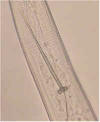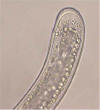|
Labial region rounded, striated (rarely smooth), offset, rounded
to roughly quadrangular in en face view; labial disc generally not
prominent. Amphid
aperture small slit, dorso-ventrally directed.
Lateral
field with four lines. 
Stylet long (50 to 140 µm), strong. Slender and finely pointed
anteriorly, cone much longer than shaft.
Photomicrograph by I.A. Zasada of a dislodged stylet of Neodolichodorus
obtusus.
Tail short,
hemispherical, rarely conical. 
Phasmids adanal or slightly anterior to
anus.
|